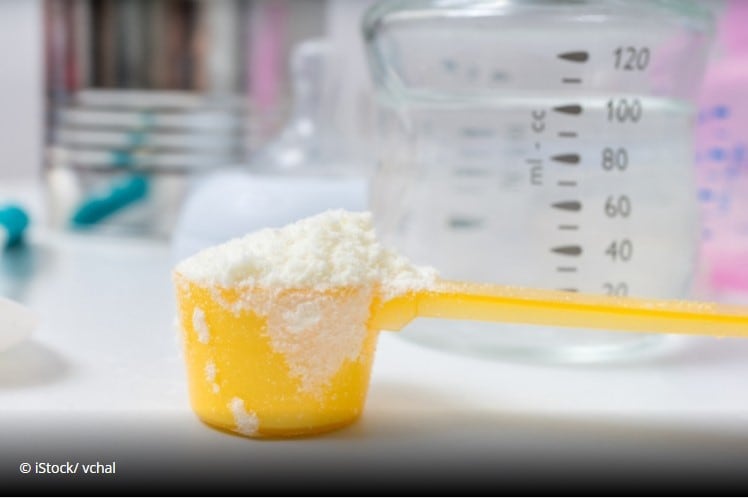Products made from human milk are expected to flood the market targeting hospitals treating premature babies, but more research is needed to assess their effectiveness, researchers say.
More studies are needed to prove whether it is advantageous for human milk to go through the same homogenisation processes as animal milk and how it could impact the bioactive ingredients.
Dairy farmers use homogenisation to improve cow milk’s taste, consistency and appearance as well as extending its shelf life – it also disperses the fat droplets and stops the cream rising to the top by evenly dispersing two liquids to create a single uniform mixture.
The article, published in a Current Developments in Nutrition Journal, focuses on changes to the macromolecular structure of the milk fat globule (MFG) and subsequent impact on digestion. The authors say that change in the macromolecular structure of the milk fat globule can alter digestion kinetics and the bioavailability of nutrients, especially proteins, fats, and fat-soluble nutrients. The implications of such changes on preterm infant health outcomes have been inadequately investigated, the researchers say.
The milk fat globule is the primary vesicle that delivers fat and fat-soluble nutrients to the infant. The native milk fat globule consists of an inner core of triglycerides surrounded by a lipid bilayer derived from a plasma membrane, called the milk fat globule membrane (MFGM). This membrane contains numerous embedded lipids, proteins, and carbohydrates including sphingolipids, phospholipids, proteins, glycoproteins, gangliosides, and cholesterol that are important for protection against pathogens, maturation of the infant gut, and the development of the immune, metabolic, and central nervous systems. The structure of the MFGM and the roles of its various components have been reviewed in detail.
The researchers said: “The impact of homogenisation on human milk fat globules. Homogenisation disrupts the MFGM, leading to adsorption of milk serum proteins, including whey proteins, casein micelles, and casein micelle fragments. The resulting smaller fat droplets coated with milk serum proteins interact differently with digestive enzymes such as gastric and pancreatic lipases, rendering them more susceptible to premature digestion in the stomach.”
The paper notes that homogenisation disrupts the fat globule which may lead to premature digestion of bioactive compounds including sphingolipids – that participate in tissue development, cell recognition and adhesion, they also act as receptors for toxins – and long chain polyunsaturated fatty acids (LCPUFAs) that have been linked to favourable neurological outcomes. The implications of these changes for infant health are unknown according to the authors.
Premature babies weighing less than 1250 gs and feeding on an exclusive human milk diet (EHMD) had less heath complications than those consuming cow milk-based diets. According to this report, this means there will be an influx of newly available products on the market including homogenised donor human milk-based fortifiers.
The researchers said: “Existing literature demonstrating the benefits of an EHMD, however, is limited to non-homogenized HM-based products. Herein, we summarise existing evidence on the impact of homogenisation on human milk, with a strong focus on changes to the macromolecular structure of the milk fat globule and the subsequent impact on digestion kinetics. We use these published data to create a conceptual framework for the potential implications of homogenised human milk-based nutritional products on preterm infant health. Importantly, we underscore that the safety and efficacy of these products warrant investigation.”
This hypothesis gained traction after evidence showed that faecal excretion of fat is lower in infants fed homogenized HM than in those fed non-homogenized human milk.
"Human milk-based nutritional products are not created equally," said Melinda Elliott, one of the authiors who is also chief medical officer for Prolacta, a private company advancing the science of human milk. "As human milk researchers and medical professionals, it is our opinion that the use of industrial processing techniques such as homogenisation, with or without high-heat processing, should be avoided for human milk-based nutritional products until their safety and efficacy have been established."
In summary, the researchers found that homogenisation disrupts the milk fat globule, which may lead to premature digestion of bioactive components linked to favourable neurological outcomes including sphingolipids and long-chain polyunsaturated fatty acids – the implications of which for infant health are unknown. The described clinical benefits of human milk-based nutritional products have not been established and more research is needed.
Source: Current Developments in Nutrition
Publshed: doi.org/10.1093/cdn/nzab147
'Human Milk and Human Milk–Based Fortifiers and Implications for Preterm Infant Health'
Authors: Sarah M Reyes, Biranchi Patra and Melinda J Elliott





